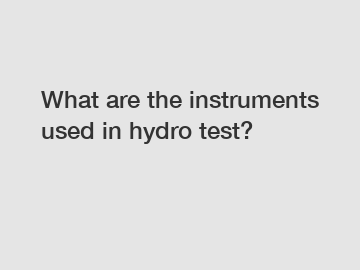What are the instruments used in hydro test?
Hydro testing, also known as hydrostatic testing, plays a crucial role in various industries where safety and reliability are paramount. This testing method involves pressurizing equipment or pipelines with water to verify their integrity and detect potential leaks or weaknesses. To carry out this process with utmost precision and accuracy, a range of specialized instruments are employed. In this article, we delve into the essential instruments used in hydro testing, highlighting their significance and the role they play in ensuring the safety of critical infrastructure.
1. Pressure Gauges:
At the heart of any hydro test is a pressure gauge, which measures and displays the pressure within the system being tested. These gauges come in various types, including analog, digital, and differential pressure gauges. By providing real-time monitoring of pressure levels, they allow technicians to adjust conditions accordingly and ensure that the tested equipment can withstand the required pressure without compromise.

2. Relief Valves:
When performing a hydro test, it is vital to have a backup safety measure in the event of pressure exceeding safe limits. Relief valves are installed in the system to release excess pressure automatically, safeguarding both the equipment and personnel from any potential damage or injury. These valves should be carefully selected to match the test parameters and calibrated appropriately for accurate relief at the desired pressure thresholds.
3. Pressure Recorders:
Pressure recorders are widely used to maintain a detailed record of pressure changes during a hydro test. These instruments enable continuous monitoring and recording of pressure values at regular intervals. By analyzing the recorded data, technicians can identify any pressure fluctuations or hazardous trends that may necessitate further analysis or adjustments to ensure equipment safety.
4. Calibrated Test Pumps:
Test pumps are the backbone of hydro testing, responsible for pressurizing the system with water. These pumps must be calibrated precisely to deliver the desired pressure range consistently. Having a reliable and accurate test pump is vital to achieving accurate results and ensuring the equipment's structural integrity. Regular maintenance and calibration of the test pumps are essential to guarantee their performance and reliability.
5. Deadweight Testers:
Deadweight testers are highly accurate instruments used to calibrate pressure gauges and pressure transmitters. These devices create a known and controlled pressure that is applied to the gauge or transmitter under test. By comparing the reading of the gauge with the known pressure applied, technicians can ensure the accuracy of the gauge, thus ensuring reliable pressure measurements during hydro testing.
6. Water Flow Meters:
Water flow meters are used to measure the rate of water flow during a hydro test. These instruments accurately determine the volume of water passing through the system, providing valuable data for verifying flow consistency and identifying potential blockages or restrictions. By ensuring consistent water flow throughout the test, flow meters contribute to the accuracy and reliability of the entire hydro testing process.
7. Leak Detection Equipment:
While pressure gauges and relief valves detect gross leaks, specialized leak detection equipment is essential for identifying even the smallest leaks during a hydro test. State-of-the-art technologies such as ultrasonic leak detectors and tracer gases aid in locating leaks that may not be visually apparent. By employing these instruments, technicians can identify and rectify leaks promptly, ensuring the integrity and safety of the tested equipment.
Conclusion:
The efficiency and accuracy of hydro testing are heavily reliant on the proper selection and use of instruments specifically designed for this purpose. Pressure gauges, relief valves, pressure recorders, calibrated test pumps, deadweight testers, water flow meters, and leak detection equipment are all integral in carrying out a thorough and reliable hydrostatic test on critical equipment or pipelines. By utilizing these instruments along with expertise, strict adherence to safety protocols, and continuous training, industries can ensure the integrity and longevity of their infrastructure, setting the stage for safe operations and long-term success.
For more information, please visit air pressure testing machine, air booster valve, refilling machine.

Comments